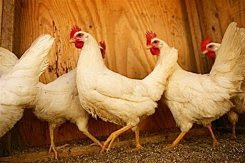Listen up, peeps–your voice does matter, and it can make a difference. I know many folks speaking out against the liberal use of antibiotics in animal feeds, and the governing bodies are listening. In late May, consumer groups lodged complaints with the Food and Drug Administration denouncing the widespread use of antibiotics in animal feed and urged the agency to do more to halt the practice. And just recently the World Health Organization (WHO) has recommended restricting and even eliminating the use of antibiotics to boost animal growth. Bravo!
Limiting the use of antibiotics in animal husbandry is suggested to reduce the risk of developing and transmitting resistant microbes to humans. Antibiotic resistant bacteria, like Methicillin-resistant Staph aureus (MRSA), are believed to be transmissible to humans via farm animals, particularly pigs. The mode of transmission can include meat consumption, being in close contact with the animals, or through the environment (groundwater contamination).
The European Union has already banned most antibiotics in animal feeds (with the exception of two in poultry feeds) since 2006, and Scandinavian studies have shown that restrictions have led to a decrease in resistant animal bacterial populations.
MRSA is not the only drug-resistant bacteria on the rise in animal products, either. Bacteria resistant to fluoroquinolones and the most recent generations of cephalosporins have become more common. Both these classes of drugs are considered essential to human health as a last line of defense to combat the most stubborn infections. Resistance to third and fourth generation cephalosporins in Salmonella Heidelberg infections in humans has been increasing over the last several years.





















